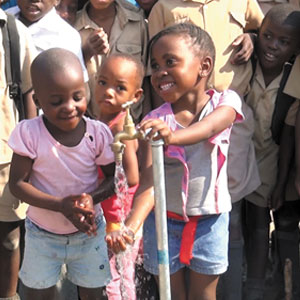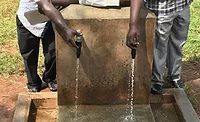Franklin Electric Charity Solves Water Issues in Rural Africa, Latin America

|
| Franklin Wells for the World Foundation plans to work in 2014 on water supplies for five schools in the Chibombo District in Zambia. Source: Franklin Wells for the World Foundation |
Several years ago, Franklin Electric Co. became aware that thousands of children die every day in Africa from diseases caused by drinking dirty surface water. A world leader in accessing groundwater, the company knew that solving the crisis was as simple as digging 200 feet below their feet.
Franklin Electric launched Franklin Wells for the World Foundation Inc. (FWWF) in 2010 with a mission to provide clean water to developing regions in Africa and Latin America.
In 2013, FWWF installed wells on six sites in Zimbabwe’s Tsholotsho District, made up of schools, clinics and community centers. Using solar–technology pumps that push water into storage tanks during daylight hours, the wells brought clean water to more than 12,000 people.
Attie Jonker, director of FWWF, has been with the foundation since its inception. He handles every project from beginning to end. National Driller reached across the Atlantic, to Jonker’s post in South Africa, to learn more about the clean water initiative.
Q. What does FWWF do?
A. FWWF is a charitable organization whose board members and staff members are chosen to serve the public purposes for which it is dedicated. Our focus is providing clean drinking water … and to make sure that the projects are sustainable into the future — very much the approach of teaching the people to fish rather than handing out fish.
Q. What is FWWF doing now?
A. The FWWF board has just approved the 2014 budget for five schools in the Chibombo District in Zambia, very similar to projects done last year in Tsholotso, Zimbabwe.
Q. How is FWWF funded?
A. The funding for FWWF is from within the Franklin Electric organization.
Q. What technology does FWWF deploy in its work?
A. During the evaluation phase of each project we will determine the best technology suited for the application. The advantage FWWF is enjoying is that all technologies from solar–powered pumps, diesel–driven pumps, hand pumps and electric submersible pumps are in-house manufactured, making it easy to select the best solution.
Q. How does FWWF choose project locations?
A. Most of the projects come from word of mouth. The need for fresh, clean drinking water is so great that it’s not so easy to differentiate as to where the need is the greatest. However, FWWF is focusing on smaller projects, communities between 2,500 and 10,000 people, which are not normally on the radar screens of the larger donors.
Q. What kind of an impact is FWWF making?
A. The impact of having fresh drinking water available is immense on the lives of the people in the communities where we do these projects. It’s not only providing drinking water but it’s also helping with the eradication of water-borne diseases, which normally occur in rural areas. Furthermore, for each project we plan to have enough water available for the people’s daily needs and for the development of vegetable gardens whereby we involve the community. This approach ensures that the projects are sustainable into the future.
Q. What challenges does FWWF face?
A. The remoteness and accessibility, and to get contractors willing to work in these remote areas at acceptable prices. The logistics is a nightmare. Then always the risk of malaria and other diseases. … There are a number of challenges in executing projects, but one must understand if these projects weren’t challenging, the need for water would also have been less.
Q. Goals for FWWF?
A. The goals for FWWF are to maintain its position and to make sure that every project is sustainable for many years after the handover.
Q. What do you enjoy most about the foundation?
A. The absolute fulfillment of helping people with water, which we so easily daily take for granted, and the appreciation from the communities is indescribable.
Valerie King is a freelance writer for National Driller.
Looking for a reprint of this article?
From high-res PDFs to custom plaques, order your copy today!



